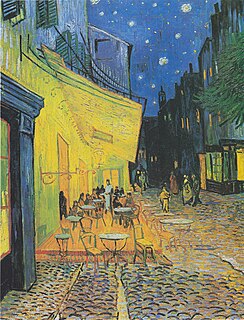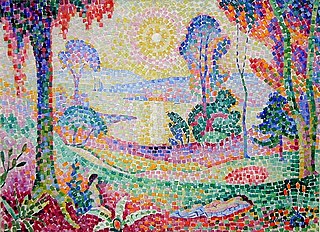 W
WSorrowing Old Man is an oil painting by Vincent van Gogh that he made in 1890 in Saint-Rémy de Provence based on an early lithograph. The painting was completed in early May at a time when he was convalescing from a severe relapse in his health some two months before his death, which is generally accepted as a suicide.
 W
WAvenue of Poplars at Sunset is an oil painting created in 1884 by Vincent van Gogh. It is held at the Kröller-Müller Museum in The Netherlands.
 W
WCafé Terrace at Night is an 1888 oil painting by the Dutch artist Vincent van Gogh. It is also known as The Cafe Terrace on the Place du Forum, and, when first exhibited in 1891, was entitled Coffeehouse, in the evening.
 W
WCart with Red and White Ox is an oil painting created in 1884 by Vincent van Gogh. It is in the Kröller-Müller Museum in Otterlo, Netherlands and may have been made either before or after Cart with Black Ox. Van Gogh painted both some four years before leaving the Netherlands for the South of France.
 W
WLe Chahut is a Neo-Impressionist painting by Georges Seurat, dated 1889-90. It was first exhibited at the 1890 Salon de la Société des Artistes Indépendants in Paris. Chahut became a target of art critics, and was widely discussed among Symbolist critics.
 W
WCoucher de soleil no. 1 is an oil painting created circa 1906 by the French artist and theorist Jean Metzinger (1883–1956). Coucher de soleil no. 1 is a work executed in a mosaic-like Divisionist style with a Fauve palette. The reverberating image of the sun in Metzinger's painting is an homage to the decomposition of spectral light at the core of Neo-Impressionist color theory.
 W
WThe Cyclops is a painting by Odilon Redon that depicts the myth of the love of Polyphemus for the naiad Galatea. It was painted in oils on board, then mounted on wood, and is now in the Kröller-Müller Museum in the Netherlands. The painting has been variously dated between 1898 and 1914.
 W
WLa danse is an oil painting created circa 1906 by the French artist and theorist Jean Metzinger (1883–1956). Bacchante is a pre-Cubist or Proto-Cubist work executed in a highly personal Divisionist style during the height of the Fauve period. Bacchante was painted in Paris at a time when Metzinger and Robert Delaunay painted portraits of one another, exhibiting together at the Salon d'Automne and the Berthe Weill gallery. Bacchante was exhibited in Paris during the spring of 1907 at the Salon des Indépendants, along with Coucher de soleil and four other works by Metzinger.
 W
WFall of Leaves , or Falling Autumn Leaves is a pair of paintings by the Dutch painter Vincent van Gogh. They were executed during the two months at the end of 1888 that his artist friend Paul Gauguin spent with him at The Yellow House in Arles, France.
 W
WFlowering Orchards is a series of paintings which Dutch artist Vincent van Gogh executed in Arles, in southern France in the spring of 1888. Van Gogh arrived in Arles in February 1888 in a snowstorm; within two weeks the weather changed and the fruit trees were in blossom. Appreciating the symbolism of rebirth, Van Gogh worked with optimism and zeal on about fourteen paintings of flowering trees in the early spring. He also made paintings of flowering trees in Saint-Rémy the following year, in 1889.
 W
WA Lane in a Public Garden in Arles is an 1888 painting by Vincent van Gogh depicting a lane running through the public garden in Arles.
 W
WA Meadow in the Mountains: Le Mas de Saint-Paul was painted by Vincent van Gogh in December 1889. It depicts fields of young wheat with a background of lilac mountains and yellowish sky.
 W
WOld Church Tower at Nuenen are names given to several oil paintings and drawings created in 1884 and 1885 by Vincent van Gogh. Most reflect the way the 12th-century church looked in its better days when its spire was intact and its foundation formidable. The spire was demolished in 1792 and the church tower was in the process of being torn down and sold for scrap as Van Gogh made the paintings.
 W
WThe Potato Eaters is an oil painting by Dutch artist Vincent van Gogh painted in April 1885 in Nuenen, Netherlands. It is in the Van Gogh Museum in Amsterdam. The original oil sketch of the painting is at the Kröller-Müller Museum in Otterlo, and he also made lithographs of the image, which are held in collections including the Museum of Modern Art in New York City. The painting is considered to be one of Van Gogh's masterpieces.
 W
WRoad with Cypress and Star, also known as Country Road in Provence by Night, is an 1890 oil-on-canvas painting by Dutch post-Impressionist painter Vincent van Gogh. It is the last painting he made in Saint-Rémy-de-Provence, France. The painting is part of the large van Gogh collection of the Kröller-Müller Museum, located in the Hoge Veluwe National Park at Otterlo in the Netherlands.
 W
WThe Wheat Field is a series of oil paintings executed by Vincent van Gogh in Saint-Rémy-de-Provence. All of them depict the view Van Gogh had from the window of his bedroom on the top floor of the asylum: a field enclosed by stone walls just beneath his window and excluded from normal life by the rear wall of the asylum grounds; beyond this enclosure farm land, accompanied by olive groves and vineyards, ran up to the hills at the foot of the mountain range called Les Alpilles.
 W
WWheat Fields is a series of dozens of paintings by Dutch Post-Impressionist artist Vincent van Gogh, borne out of his religious studies and sermons, connection to nature, appreciation of manual laborers and desire to provide a means of offering comfort to others. The wheat field works demonstrate his progression as an artist from the drab Wheat Sheaves made in 1885 in the Netherlands to the colorful, dramatic paintings from Arles, Saint-Rémy and Auvers-sur-Oise of rural France.